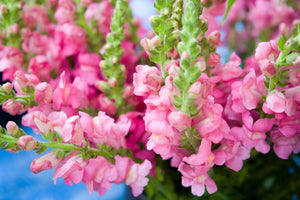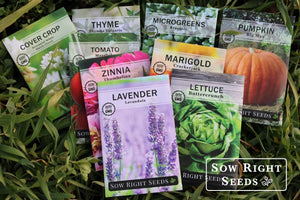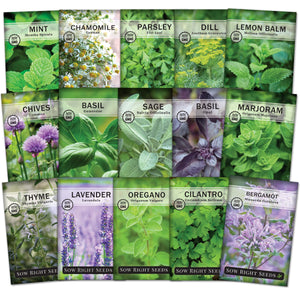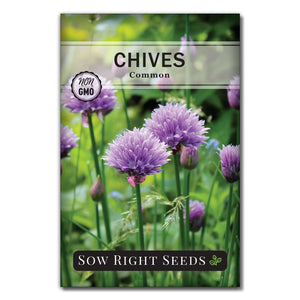How to Grow Sage from Seed to Savory Harvest
Herb growing tipsSage is one of the primary herbs for growing in an herb garden. Its fuzzy grayish-green leaves have a potent flavor that is used in many classic dishes. It also has a long history of use in traditional remedies for treating sore throats, diabetes, high cholesterol, and memory problems. Sage is an easy-to-grow perennial that will come back year after year. We’ll share all the tips and techniques you need to grow sage in your home garden.

Growing Common or Culinary Sage
There are over 900 species of sage. In this guide, we’ll cover how to grow Salvia officinalis. It is also known as common sage, culinary sage, and garden sage. In our Planter’s Library, we cover how to grow White Sage and Blue Sage.
Sage (Salvia officinalis) is a perennial herb in zones 4-10, and with care, it can be overwintered in colder zones. It grows into a woody shrub around 12 to 18 inches tall and 2 to 3 feet wide.
How to Grow Sage from Seed
Garden sage is easy to start from seed. Start sage seeds indoors 6 to 8 weeks before the last spring frost or direct sow outdoors after the last frost date.
Tips for fail-proof sage seed germination
We prefer to start sage seeds indoors to control the growing conditions for the best seed germination.
Plant sage seeds ¼” deep in seed starting mix.
Keep seeds moist until they germinate in 10 to 20 days. We like to use a spray bottle to wet the soil and then cover it with a clear plastic dome to keep the seeds from drying out.
Soil temp 65 - 70ºF is ideal for germination.
Transplanting Sage Seedlings
When sage seedlings are about 4 inches high and have two sets of true leaves, they will be ready for transplanting. Wait until all danger of frost is past. Take time to harden off seedlings before transplanting.

How to Grow Culinary Sage Plants
Sage is a beautiful plant to grow in any garden. You can add it to containers, borders, flower beds, anywhere with full sun and well-draining soil.
Sun
Sage needs full sun to grow and develop its potent flavor. Plant sage where it can receive at least 6 hours of bright, direct light. In hot summers, some afternoon shade can be beneficial.
Soil
Soil that is more on the sandy side and drains well is perfect for growing sage. The pH can be slightly acidic to neutral. If your soil has a high clay content, you will want to amend it before planting sage. Raised beds are a great place to grow sage.
Water
Sage seedlings need consistent water. Keep the soil moist but not waterlogged. Once the sage plants are established, they are drought tolerant. You will only need to water when the soil is dry below 1 to 2 inches.
Fertilizer
Even though adding fertilizer will result in vigorous plant growth, it is not recommended. Like other herbs, the potent flavor of sage will be weakened when it has too much growth. Skip the fertilizer and apply compost in the spring when growing sage for culinary use.
Pruning
Pruning every spring will encourage new growth and help keep the sage plant's center from becoming woody. You can also prune during the growing season to shape the plant. Sage will eventually become a woody plant and can be divided or replaced after a few years.
Companion plants for sage
Sage is an excellent companion plant for a vegetable garden. It repels cabbage moths, carrot flies, and ticks. However, sage can stunt the growth of cucumbers. In an herb garden, plant sage next to rosemary.
Solutions for sage pests and diseases
Spider mites can be a problem on sage plants. First, try washing them off with a strong stream of water. Neem oil can also help with large infestations.
To avoid problems with powdery mildew, prune sage plants to allow airflow and avoid watering the leaves. This is especially important in areas with high humidity.
To prevent root rot, don’t overwater your sage plants. Let the soil dry between watering. Sage needs well-draining soil. If you have heavy clay soil, you will need to amend it.

Harvesting Culinary Sage
The beauty of growing your own sage is that you can harvest sage leaves as you need them. In the first year of growing sage, only take off a few leaves. In the following years, you can take leaves as you need them. Never remove more than ⅓ of the plant at a time.
How to store sage
Sage can be dried or frozen to preserve.
To dry sage, hang bundles of leaves in a well-ventilated area. Let it dry until it crumbles easily. Store dried sage in an airtight container away from heat and light.
To freeze sage, place individual leaves in the freezer. You can also add leaves to olive oil and freeze them in cubes for cooking.
Sage FAQs
Can you grow sage in pots?
Sage can easily be grown in containers. In zone 5 and lower, this is a great way to bring herbs indoors during the winter. Make sure the pots can drain well.
Can you grow sage indoors?
Sage can be grown indoors if it receives enough light. It will need at least 6 hours of direct light from a window or 12 hours of supplemental light.
We love growing sage in our kitchen herb garden. The beautiful leaves and fragrance alone are worth it. Try growing sage and using it fresh in your traditional Thanksgiving recipes. Or find new and creative ways to use sage with your abundant harvest.
Written by Beverly Laudie
Found this information helpful? Share it with your gardening friends!










Barbara, a good spacing for sage plants is 15 inches.
kindly share the spacing at transplanting
Leave a comment